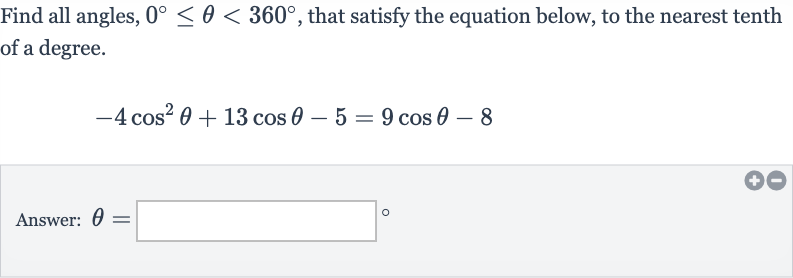Full solution
Q. Find all angles, , that satisfy the equation below, to the nearest tenth of a degree.Answer:
- Rewrite Equation: First, let's rewrite the given equation to collect like terms on one side:
- Combine Like Terms: Now, subtract from both sides and add to both sides to get all terms involving on one side and the constant on the other side:
- Quadratic Equation: Simplify the equation by combining like terms:
- Factorize: This is a quadratic equation in terms of . Let's set to make it easier to solve:
- Solve for : Now, we can factor the quadratic equation:
- Find Possible Values: Set each factor equal to zero and solve for : or
- Discard Invalid Value: Solve the first equation for :
- Find Corresponding Angles: Solve the second equation for :\(\newline\) + = \(\newline\) = \(\newline\) =
- Final Answer: Since , we have two possible values for : and . However, the cosine of an angle cannot be greater than , so we discard the value .
- Final Answer: Since , we have two possible values for : and . However, the cosine of an angle cannot be greater than , so we discard the value .Now we find the angles that correspond to . The cosine of occurs at degrees and degrees in the range of to degrees.
- Final Answer: Since , we have two possible values for : and . However, the cosine of an angle cannot be greater than , so we discard the value .Now we find the angles that correspond to . The cosine of occurs at degrees and degrees in the range of to degrees.We can now write the final answer with the angles that satisfy the original equation: degrees, degrees

